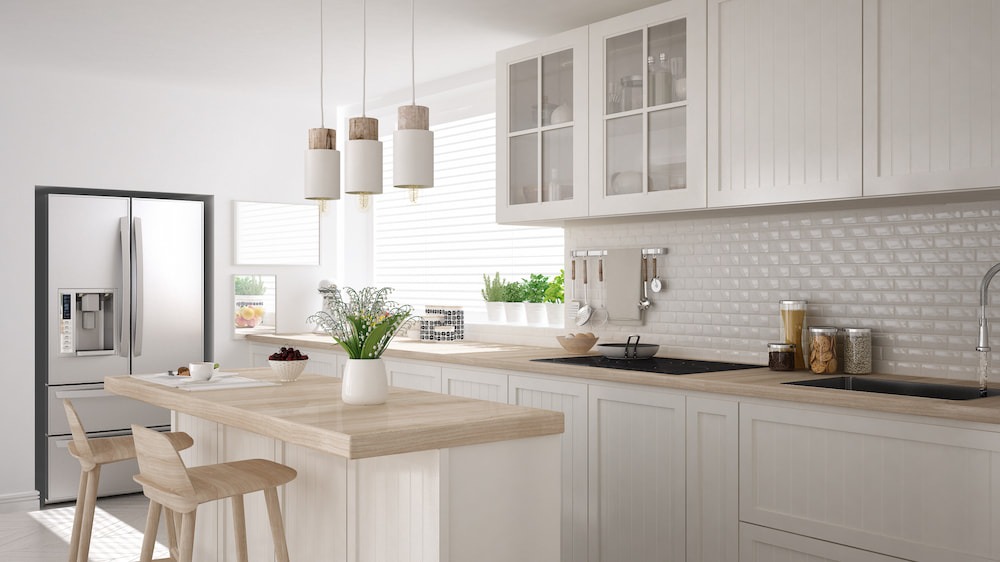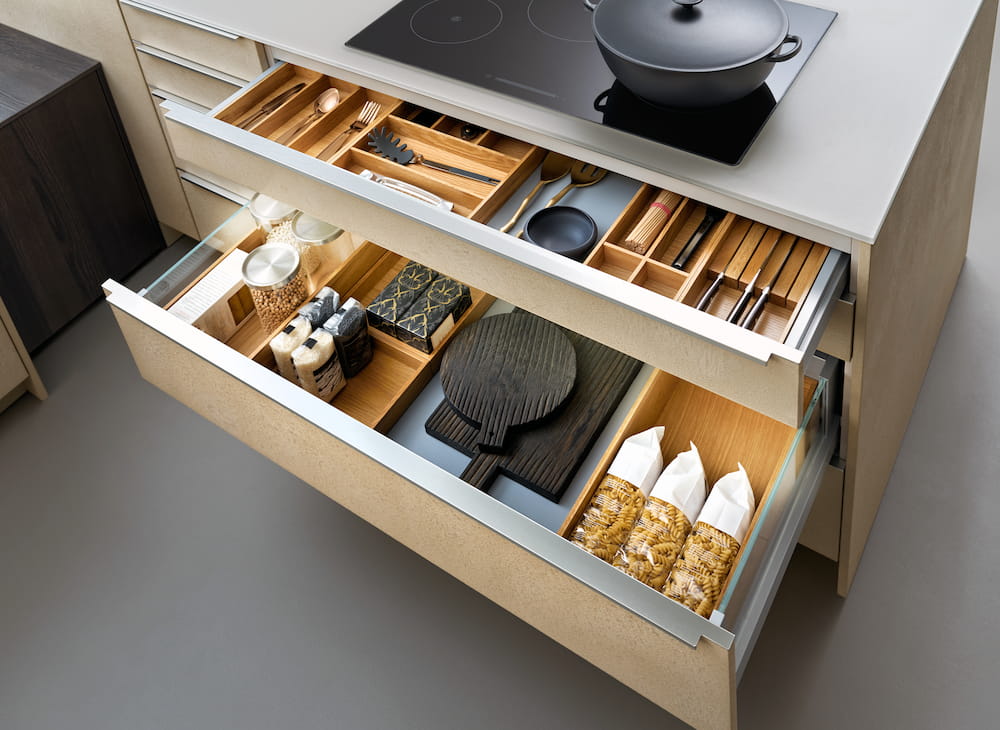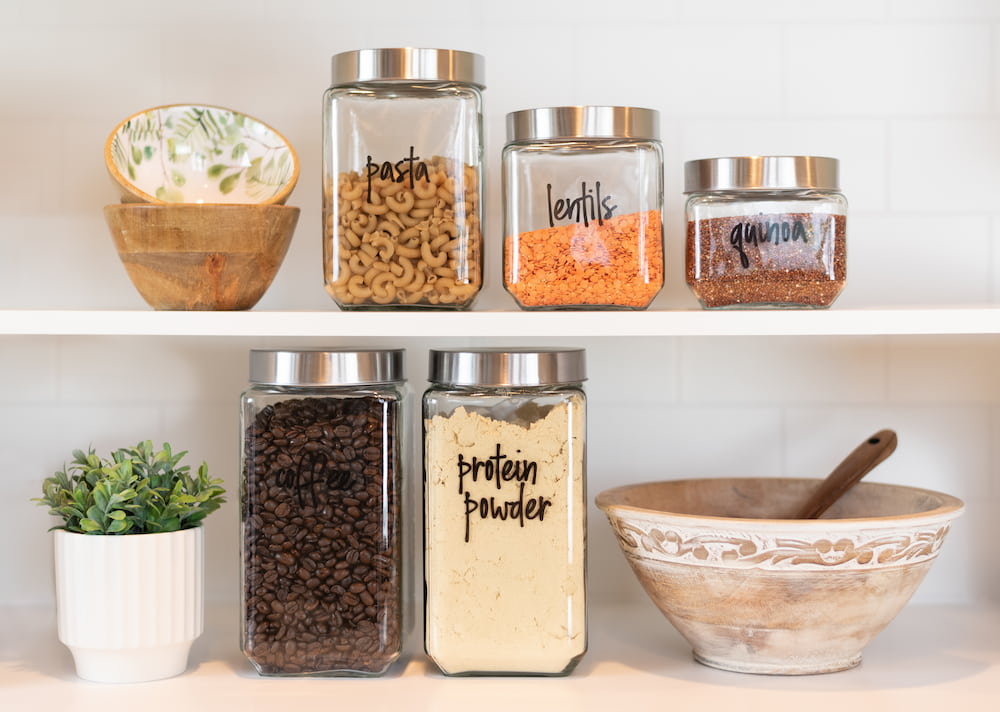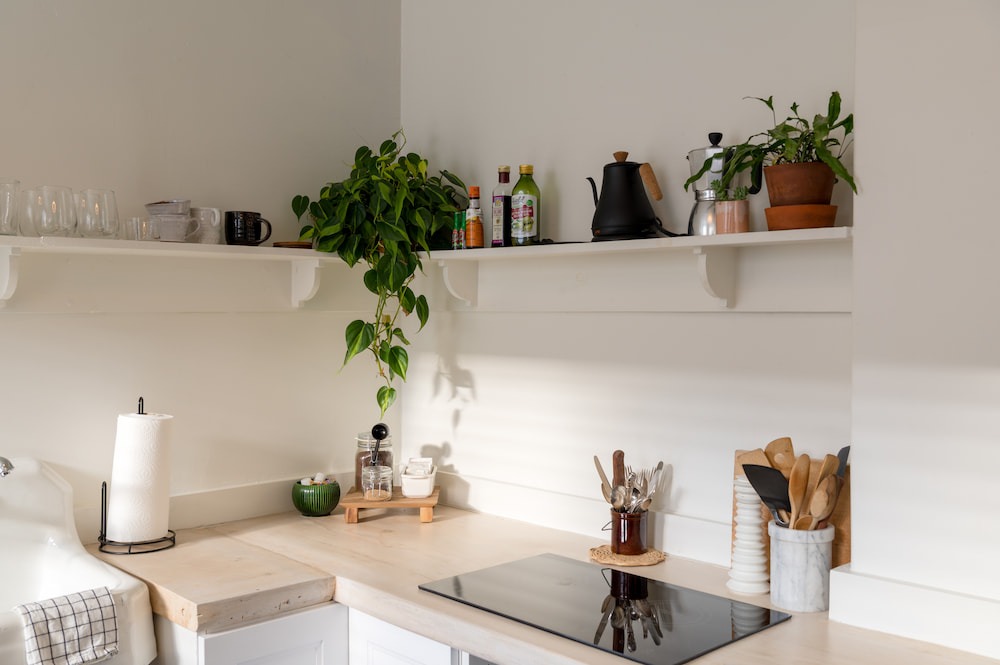How to Organize and Declutter Your Kitchen: Your Kitchen Never Looked so Good

The kitchen. Where you cook fabulous food for hungry family and friends. Tonight, your world-famous mac and cheese is on the menu, but where is the cheese grater? You dig through the cabinet, a.k.a. the black hole of small kitchen appliances and dishes, to try to find your favorite pasta pot. Then you almost burn the sauce reaching for the garlic powder, after five spices fall onto the counter.
It doesn’t have to be this difficult, does it?
No, it doesn’t! We’ve curated this list of kitchen hacks to help you declutter and organize your kitchen. You’ll never have to search for small kitchen appliances or be attacked by falling spices again.
Keep reading for our best tips and tricks to get your kitchen neat and tidy!

Start Decluttering
Decluttering is the first step to getting your kitchen in tip-top shape! Below are a few general tips so you can start decluttering like a pro.
Plan
Before you start, you have to make a plan! Create a decluttering schedule so you’re not overwhelmed. Write down all the places in your kitchen you need to declutter, along with a timeline of when you would like to get them done. Be sure to make attainable goals and keep track of your progress by writing them down.
Take it one drawer at a time
Kitchen decluttering is a major process, so the most important thing is to take it one step at a time. Stick to your decluttering plan and set out realistic, achievable tasks. Consider going through one drawer at a time, or decluttering for a certain amount of time every day.
Where to declutter
There are a lot of places where clutter can accumulate in your kitchen! Be sure to check your kitchen counters for small appliances, cookbooks, decorative items or kitchen gadgets. If you haven’t used something for a while, it’s time to either donate it or throw it away. You’ll also want to look through all your kitchen cabinets and drawers to get rid of any duplicates, old or damaged dishes, or anything that you don’t use often or don’t need.
Don’t forget to declutter all your food items, too. Take a good, long look at your pantry, fridge and freezer, and throw away anything that has expired or has freezer burn. If you have a lot of nonperishables you won’t eat, consider donating them to a food bank or shelter. Be sure to check with your local food bank to see when they’re open and what items they accept or need. Here’s a list of food banks across the U.S.
You can’t skip the junk drawer! Most often the junk drawer is filled with random items that don’t really belong anywhere. Go through every item in that kitchen drawer, and determine what you really need and what can be given away.
Clean
After going through your whole kitchen and getting rid of what you don’t need, it’s time to deep clean. We’re talking appliances, counters, cabinets and drawers, etc.
Start by degreasing the stove and cleaning inside your oven. You’ll also want to clean out your fridge and freezer, along with any other appliances. Don’t forget to clean the counters, wipe out the cabinets and drawers, and mop the floor last.
When your kitchen is completely organized and neat, you’ll be grateful you got the cleaning out of the way! Find even more cleaning tips for your kitchen in our spring-cleaning checklist and blog.

Let’s Get Organizing
Now it’s time for the fun part! We’ve compiled a list of some top kitchen organizing ideas to get you started refreshing and tidying up your kitchen.
Placement matters
Where you store items is important. Put like items together, and place items in the area they will be used. For example, place pots and pans near the stove and baking sheets or dishes near the oven. Carefully placing items will make your kitchen more efficient.
Hang your mugs
We don’t expect you to give away or toss all your coffee mugs while decluttering, but what should you do with the ones you’re keeping? Consider hanging your coffee mugs on the wall or underneath a cabinet. If you have available space on the counter, you could also use a mug tree.
Hang pots and pans
Pots and pans can take up a lot of space, so it’s crucial to use unique storage solutions for these bulky items. If you have already purchased a stackable set of pots and pans, you’re all set. But if not, consider a metal storage rack to put your pots and pans in a cabinet, or install a hanging pot rack above your island or counter. (Worried about the lids? Check out our next tip.)
Behind the door rack for pot lids
If you’re hanging your pots and pans, you need a separate spot for the lids. One of our favorite kitchen storage hacks is storing pot lids on the inside of cabinet doors. You can build a DIY lid organizer, or there are a variety of cabinet door organizers for lids you can buy.
Store spices smart
There are so many ways to store spices! Just choose the storage solution that works best in your kitchen.
A typical and reliable storage technique is a standing spice rack. Normally these sit on the counter or in a cabinet. Spices can also be stored in a hanging spice rack (on a cabinet door), on a lazy Susan, or even in a magnetic spice rack you can put on the side of the fridge!

Jars
Glass jars are the ultimate hack for keeping your pantry organized! Keeping your flour, sugar, salt and pepper in matching jars is both aesthetically pleasing and neat. You can also store a variety of dry goods such as cereals, baking goods, pasta and more in large food storage containers. Just be sure to label everything!
Drawer organizers
In order to prevent all your drawers from looking like your old junk drawer, be sure to get some drawer organizers. You can get adjustable organizers for small utensils, silverware, measuring cups and more. If you have a large knife collection, consider devoting one drawer to knife storage.
Pro tip: If you’ve got small children, use a safety drawer lock to keep them out of the knife drawer, or get a knife block that can be stored up high, like atop the refrigerator.
Utensil storage
Small cooking utensils can be stored in drawers with drawer organizers, but your large utensils may be better kept in large jars or pots on the counter. If you have minimal counter space, these utensils can also be hung from a wall-mounted rack, or hung underneath cabinets.
Vertical separators for cabinets
Storing large, flat items like baking sheets, cutting boards and cooling racks can be tricky, but not if you have the right storage solution. Get a divider and store these kitchen items vertically in tall cabinets. You can also dedicate a whole cabinet to these items, just check out this DIY baking sheet storage solution from HGTV.
Refrigerator organization
An organized icebox is so satisfying! Keep your fridge neat by using various sizes of containers and shelves (including an egg container, large glass or juice container, can dispenser, etc.). Marie Kondo suggests leaving your fridge about one-third empty for leftovers or extra groceries. Don’t forget to check your fridge for expired items on a regular basis!
Hang produce
There are numerous ways to store fresh produce, so you have options to choose from! Consider using wall storage baskets or purchasing a hanging fruit basket. If you have space on the counter, use a standing fruit basket, but not a solid ceramic or glass bowl! Keeping fruit in a solid bowl limits air circulation and makes the fruit spoil more quickly.
Organize cleaning supplies
You’ve just cleaned your whole kitchen, so now you know exactly how many cleaning supplies you have (and need). Try using a tension rod under the kitchen sink to hook spray bottles, add shelves to the inside of cabinet doors, or put your cleaning products on an expandable under-sink organizer to get organized.
Plastic bag organizer
Have plastic bags overtaken your kitchen? It’s time to get them under control! Consider putting them in an empty cardboard tissue box or in a Pringles can. Find more unique storage solutions for plastic bags in this blog.

FAQs Kitchen Decluttering and Organizing
Q: What is the most efficient way to organize a kitchen?
A: A few great tips for efficiently organizing your kitchen include creating designated workspaces and making sure commonly used items are easily accessible. Be sure to utilize some of our organizing hacks above for a neat, uncluttered kitchen!
Q: How do you organize a cluttered kitchen?
A: If you’re ready to organize your kitchen, you’re in the right place! The first step is to declutter. Go through every cabinet and drawer, your pantry, the fridge and freezer, and donate or toss anything you don’t need. Then give your kitchen a deep clean, and try out some of our unique organizing tips to make the most of your space.
Q: Where should dishes go in the kitchen?
A: Generally, you should store your dishes in a cabinet near the sink or dishwasher. Put other kitchen items close to where they will be used. For example, put mixing bowls and cutting boards close to where you will be prepping food.
Q: What should you not throw out when decluttering?
A: While decluttering it’s a good idea to keep family heirlooms, important documents, photos or items that could be hard to replace. Decluttering is an essential process to organize and tidy your home, but it’s more than okay to keep items that are important to you or hold sentimental value.
A Job Well Done: Decluttering and Organizing the Kitchen
After following our guide, your kitchen will be ready for it all. Start slicing, dicing, grilling and spilling (it’s okay, your cleaning products are ready, too). What was your favorite kitchen decluttering or organizing hack? Let us know in the comments below! A storage unit can come in handy while moving, renovating or even decluttering your kitchen. If you ever need more space, find your nearest Store Space with our storage location finder.







